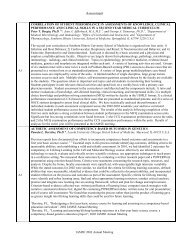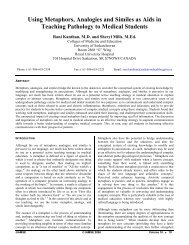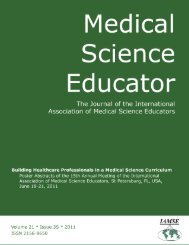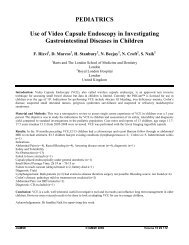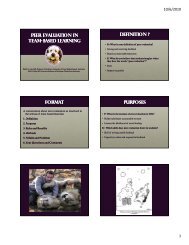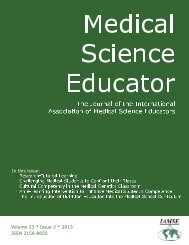Click here to view complete journal in pdf-format - IAMSE
Click here to view complete journal in pdf-format - IAMSE
Click here to view complete journal in pdf-format - IAMSE
Create successful ePaper yourself
Turn your PDF publications into a flip-book with our unique Google optimized e-Paper software.
CONCLUSIONS<br />
This study is a work <strong>in</strong> progress but early results<br />
suggest that the <strong>in</strong>troduction of the Drug Drill has<br />
focused much needed attention <strong>to</strong> the study of<br />
specific drugs and drug classes throughout the WR2<br />
curriculum. Additionally, requir<strong>in</strong>g students <strong>to</strong><br />
concentrate on understand<strong>in</strong>g dist<strong>in</strong>ctive features of<br />
drugs appears <strong>to</strong> be an effective re<strong>in</strong>forcement of<br />
fundamental pr<strong>in</strong>ciples of pharmacok<strong>in</strong>etics and<br />
pharmacodynamics. Student perceptions of the role<br />
the Drug Drill plays <strong>in</strong> their learn<strong>in</strong>g will be<br />
available for presentation at the time of the<br />
conference.<br />
TBL/PBL Abstract ID: 219<br />
SUCCESSFUL TRANSITION TO A HYBRID<br />
NEUROSCIENCE CURRICULUM<br />
Carl Marfurt, Indiana University School of<br />
Medic<strong>in</strong>e-Northwest, Gary, IN, USA<br />
PURPOSE<br />
The challenges of teach<strong>in</strong>g an <strong>in</strong>tegrated medical<br />
neuroscience course <strong>in</strong>clude help<strong>in</strong>g students<br />
master an <strong>in</strong>creas<strong>in</strong>gly substantial and cl<strong>in</strong>ically<br />
oriented core curriculum <strong>in</strong> a limited time frame,<br />
while provid<strong>in</strong>g a flexible curriculum that<br />
accommodates diverse student learn<strong>in</strong>g styles. This<br />
report describes our transition from a “traditional”<br />
lecture-based neuroscience course <strong>to</strong> a “hybrid”<br />
course with greater emphasis on <strong>in</strong>dependent study<br />
and small-group learn<strong>in</strong>g modules.<br />
METHODS<br />
Neuroscience is a six week block with all classes<br />
end<strong>in</strong>g before noon. The course consists of 29<br />
optional Powerpo<strong>in</strong>t presentations (annotated with<br />
SMART Sympodium and recorded us<strong>in</strong>g Camtasia<br />
Studio), four wet-labs, six PBL sessions and five<br />
TBL sessions. Ten additional pre-recorded lectures<br />
and labora<strong>to</strong>ry pre<strong>view</strong>s are posted on the course<br />
website for student study at a time of their choos<strong>in</strong>g.<br />
Labora<strong>to</strong>ry study of CNS <strong>in</strong>ternal organization is<br />
almost entirely student self-directed, us<strong>in</strong>g digitized<br />
collections of sta<strong>in</strong>ed sections, illustrated “lesionlocalization”<br />
case studies, <strong>in</strong>teractive MRI atlases,<br />
and neurology patient video clips posted on the<br />
class website.<br />
RESULTS<br />
Class performances on the NBME Neuroscience<br />
shelf exam have been well above the national mean.<br />
Formal course evaluations and student-generated<br />
Cont<strong>in</strong>uous Quality Improvement (CQI) surveys<br />
reveal high levels of student satisfaction with course<br />
organization, balance between faculty-directed and<br />
student-directed learn<strong>in</strong>g activities, and flexibility<br />
that allows/encourages students <strong>to</strong> select learn<strong>in</strong>g<br />
resources and strategies that most closely match<br />
their learn<strong>in</strong>g styles.<br />
CONCLUSIONS<br />
The transition <strong>to</strong> a hybrid neuroscience curriculum<br />
required f<strong>in</strong>d<strong>in</strong>g an optimal balance between<br />
faculty-directed and student-directed learn<strong>in</strong>g<br />
activities. Faculty cont<strong>in</strong>ue <strong>to</strong> provide students with<br />
high quality resources (<strong>in</strong>clud<strong>in</strong>g PBL and TBL<br />
cases) that help them master the volum<strong>in</strong>ous,<br />
cl<strong>in</strong>ically-relevant core curriculum, while respect<strong>in</strong>g<br />
and encourag<strong>in</strong>g the student’s strong desire <strong>to</strong><br />
personalize the learn<strong>in</strong>g process.<br />
TBL/PBL Abstract ID: 220 eDemo<br />
COMBINING TBL AND A COOKING DEMO<br />
TO TEACH LIPID METABOLISM,<br />
NUTRITION AND CARDIOVASCULAR<br />
DISEASE<br />
Chayan Chakraborti, MD 1 , Timothy S. Harlan, MD 1<br />
and David S. Frankl<strong>in</strong>, PhD 2 1 Department of<br />
Cl<strong>in</strong>ical Medic<strong>in</strong>e; 2 Department of Biochemistry<br />
and Molecular Biology. Tulane University Health<br />
Sciences Center and School of Medic<strong>in</strong>e, New<br />
Orleans, LA, USA<br />
PURPOSE<br />
Tulane University formed a collaboration with<br />
Johnson & Wales University us<strong>in</strong>g the active<br />
learn<strong>in</strong>g TBL <strong>format</strong> for metabolic biochemistry<br />
concepts, and how they apply <strong>to</strong> the prevention<br />
and/or treatment of Cardiovascular Disease (CVD).<br />
A cook<strong>in</strong>g demonstration and its associated<br />
teach<strong>in</strong>g kitchen serve <strong>to</strong> re<strong>in</strong>force these basic<br />
science pr<strong>in</strong>ciples with an <strong>in</strong>novative application of<br />
nutrition, and provide practical opportunity for<br />
student-patient <strong>in</strong>teractions as part of the student’s<br />
community-based education.<br />
METHODS<br />
The TBL focuses on biochemical concepts of lipid<br />
metabolism and nutrition <strong>in</strong> context <strong>to</strong> the<br />
development and treatment of CVD. Such concepts<br />
<strong>in</strong>clude characteriz<strong>in</strong>g fatty acid (FAs) <strong>in</strong> our diet,<br />
digestion and absorption, lipid malabsorption,<br />
major lipoprote<strong>in</strong> complexes, and approaches <strong>to</strong><br />
Therapeutic Lifestyle Changes <strong>to</strong> reduce the risk of<br />
CVD. The cook<strong>in</strong>g demonstration <strong>in</strong>volves<br />
discussion of common dietary lipids, and how they<br />
are applied <strong>in</strong> various recipes. Two chefs from<br />
Johnson and Wales cook simple recipes, from which<br />
students can learn how these <strong>in</strong>gredients are used.<br />
Students are encouraged <strong>to</strong> volunteer <strong>in</strong> local<br />
teach<strong>in</strong>g kitchens <strong>in</strong> an <strong>in</strong>novative patient-applied<br />
sett<strong>in</strong>g.<br />
Medical Science Educa<strong>to</strong>r © <strong>IAMSE</strong> 2012 Volume 22(4S) 323



